
Upcoming Lectures
This lecture series is sponsored by the Materials Research Institute, Chemistry, Physics, Engineering Science and Mechanics, and Nuclear Engineering Departments
October 23, 2024
12:20 p.m. - 1:10 p.m.
W-203 Millennium Science Complex
University Park, PA
Exploiting automatic image processing and in-situ transmission electron microscopy to understand the stability of supported nanoparticles
 Dr. Eric Stach
Dr. Eric Stach
Robert D. Bent Professor of Engineering,
Department of Materials Science and Engineering
University of Pennsylvania
Abstract:
The activity and lifetime of heterogeneous catalysts are linked with their structural stability in reactive environments. We have developed and exploited machine learning methods to track the temporal evolution of Au nanoparticles deposited on SiN as a model system to understand this process. We describe how a systematic investigation of dataset preparation, neural network architecture, and accuracy evaluation lead to a tool for determining the size and shape of nanoparticles in high pixel resolution TEM images. We use this algorithm to generate data regarding the complexities of nanoparticle coarsening, ripening, and sublimation. We have developed an analytical model that describes this process, showing how local and long-range particle interactions through diffusive transport affect sublimation. The extensive data allows us to determine physically reasonable values for the model parameters, quantify the particle size at which Gibbs-Thompson pressure accelerates the sublimation process, and explore how individual particle interactions deviate from mean-field behavior. We observe that sublimation proceeds by sequential facet/defacetting transitions, and utilize Kinetic Monte Carlo and Density Functional Theory to show how mobile adatoms form through desorption from low-coordination facets and subsequently sublimate. These results help to rationalize why evaporation rates vary between particles in a system of nearly identical nanoparticles. Recent work has extended this beyond the model case of Au to investigate Pt nanoparticles, which find ubiquitous use in heterogeneous catalysis. We’ll describe how the reactivity of Pt with the Si substrate leads to silicide formation, which has very strong effects on the evolution of Pt nanoparticles.
Short Bio:
Eric Stach is the Robert D. Bent Professor of Engineering in the Department of Materials Science and Engineering at the University of Pennsylvania, Scientific Director of the Singh Center for Nanotechnology, and Director of the Laboratory for Research on the Structure of Matter, a National Science Foundation sponsored Materials Research Science and Engineering Center. He received his B.S.E from Duke University, M.S.M.S.E. from the University of Washington, his Ph.D. in Materials Science and Engineering from the University of Virginia, and an M.B.A at Stony Brook University. He has held positions as Staff Scientist and Principal Investigator at the National Center for Electron Microscopy at the Lawrence Berkeley National Laboratory, then as Associate, and subsequently appointed Full Professor at Purdue University. Prior to his appointment at Penn he was a Group Leader at the Center for Functional Nanomaterials, Brookhaven National Laboratory. He is a Fellow of the American Physical Society, Materials Research Society, and the Microscopy Society of America.
